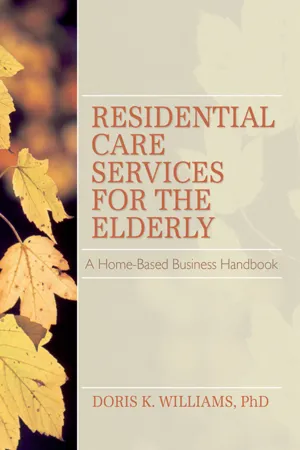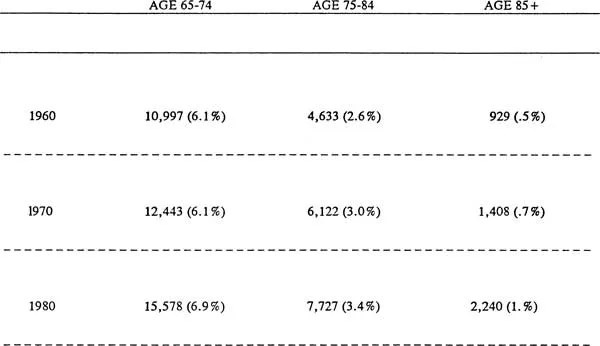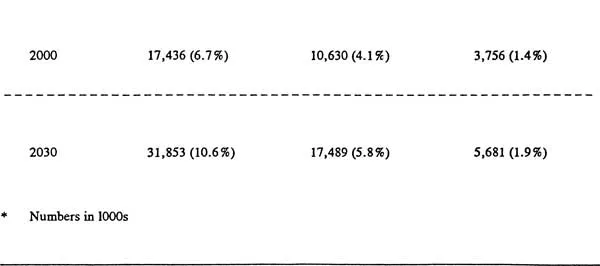![]()
Chapter 1
Background: Defining the Need for Residential Care Homes
The condition of a large elderly population is new. This is the first time in world history that such a large proportion of the population is 65 years of age and over. The average life span in ancient Greece was only 18, but by 1600 in the U.S. it was 33; in 1900 it was 47; in 1970 it was about 70, and a child born in 1987 can expect to live to be 74.9. With this “new” elderly population, there has been an emerging social awareness of the impact of senior citizens on society as it functions (see Box 2).1
Box 2
Growth and Need to Plan
By 2010 there will come a remarkable surge in the numbers of older persons as the post-war baby boom matures. In less than 30 years, an aging society will be upon us, whether we have prepared for it or not.
The very old, while making up only about 9% of the older population in 1980, will account for almost one-fourth of the projected growth in the older population over the next 20 years. If we anticipate and plan for this momentous social event now, individuals and families can still adjust their own expectations and plans for the future.
The concerns of the elderly have become concerns of the nation. The aging of the American population is both a success story today and a challenge for the future. Older people, who are rapidly growing in number and in proportion to the total population, are living proof of progress this nation has made in health care including longterm care, nutrition, housing, and other critical human service areas (Rogers, 1986). Table 1 clearly shows how rapidly the numbers of elderly are increasing.
Table 1
Number of Persons 65+ in U.S.
1900 to 2030
In 1987 there were 17.7 million older women and 12.1 million older men, or a sex ratio of 146 women for every 100 men. The sex ratio increased with age, ranging from 120 for the 65-69 group or a high of 256 for persons 85 and older. Since 1900, the percentage of Americans 65 + has tripled (4.1% in 1900 to 12.3% in 1987), and the number increased over nine times (from 3.1 million to 29.8 million).
The older population itself is getting older. In 1987 the 65-74 age group (17.7 million) was eight times larger than in 1900, but the 75-84 group (9.3 million) was 12 times larger and the 85 + group (2.9 million) was 23 times larger. The older population is expected to continue to grow in the future (see Tables 1 and Tables 2). By the year 2030 the “over 85” group, which is the most vulnerable to poor health and therefore has the greatest need for long-term care facilities, will almost triple (AARP, 1988).
Table 2
U.S. Residents, 65 Years and Older, 1960 - 2030*
Though the family is the primary caregiver for the elderly, its structure is changing and this will influence caregiving in the future (Research & News Update, 1988).2
Some examples of these changes are the increasing divorce rate, which may decrease the availability of a spouse as a caregiver; the decreasing size of the American family, which leaves fewer children available to support parents; and the increased participation by women in the labor force, which decreases the amount of informal care available in the home. In addition, the children of today’s elderly are themselves approaching their retirement years and may be less physically and financially able to assist older parents.
In view of this rapidly emerging social situation, more facets of our society are, for the first time, considering this age group: its characteristics, problems, assets, liabilities and impact on the entire society. Regardless of causes, there is a serious need for planning and facilitating long-term care environments.3
Need for Residential Care Homes
According to Sirocco (1988), the Inventory of Long-Term Care Places indicated that, of all types of long-term care facilities of three beds or more, the for-profit residential homes with 20 beds or less were smallest in number. The West had smaller sized units, but Sirocco hypothesized that this was because the population in this region is more dispersed. Persons in residential facilities, as compared with nursing homes, tended to be younger. In addition, residential facilities displayed much more variation by ownership than did nursing homes.4
One Advance Data Survey (Sirocco, 1987), indicated that the greatest number (4,578) of residential homes has 3-9 beds, the second greatest number (2,626) has 10-24 beds and the third (1,074) has 50-74 beds. By far they are profit-making businesses (as compared with government or non-profit) and the greatest percent (11.6) were in the West with 8.4 percent in the Midwest.
Another study showing trends which verify the need for longterm care services is the 1987 National Hospital Discharge Survey (1988). This study found that hospital discharge rate has continued a decline that began in 1983. The 1987 rate was 138 discharges per 1000 civilian population, a 17 percent decrease in 4 years. A decade ago the average length of stay was 7.6 days and in 1987 it was 6.4 days. This decline could indicate the need for intermediate care facilities, such as that offered by a residential home environment.5
Residential care, shelter homes or adult foster homes are often the first choice for individuals in need of long-term care. Making a decision to seek a residential home environment and selecting a home can be a difficult, often an emotional process for both the older individual and the family. The transition from the elderly’s life at home to his or her life in a group living situation can be challenging for all involved. Such change requires time to make adjustments. While there are a number of problems and concerns in regard to this transition, there are also many benefits to be gained (AARP, 1987).6
Residential homes provide families the capacity for creating new income-producing services that will meet the needs of a community in these changing times. Should families and communities create residential care, they will not only provide a much needed service for the elderly at a lower cost than institutional care, but they also will generate new jobs and income to be expended in the community (Price, 1982).
Profile of the Older Person
The elderly have a range of social and medical needs arising from a variety of life situations — especially isolated living arrangements and declining health (Halpert and Isbell, 1988).7
Some elderly persons follow a monotonous routine offering little of the mental and physical stimulation necessary for their continued development and well-being. In a sheltered environment, they can share their feelings and gain support from their peers. Even the loss of brain function can be slowed by stimulation. And, ongoing interpersonal contacts are easier to provide in a residential care program than in the traditional in-home service programs (Home Call & Oregon, 1987).
Studies suggest that up to one-third of the elderly in nursing homes are unnecessarily confined. Contrary to the stereotype, most elderly persons are relatively healthy and, even with chronic illness, are not as limited as frequently assumed. Although many elderly can no longer manage such everyday chores as preparing meals, taking medication, shopping, walking, toileting, or feeding, they do not need 24-hour nursing-care supervision, but rather assistance and socialization. Residential homes are ideally designed to provide this type of care. They might also prevent premature hospitalization.8
The problem is even more severe for the rural elderly, who are the most likely to have chronic health conditions that limit activities and to require health care assistance, even though it is less available to them than to their healthier metropolitan peers.
As the U.S. population shifts, more and more Americans will find themselves confronted with an aging parent requiring care. Help will come not from bigger and better nursing homes, but from developing ways to support a family caring system. Increasingly, residential homes are desired options for long-term care (Isabell and Halpert, 1986). Because residential home care is growing in popularity, program development, research, and public policies will need to be addressed continuously. Standards for quality programs are being refined, and communication networks and advocacy organizations for residential home operators are rapidly being organized.9
The quality of life for the frail elderly has greatly contributed to the need for this handbook. Residential homes will enable the elderly to remain in their resident communities, and this, in turn, will add to the stability and vitality of rural areas (MacLeon, 1987).
![]()
Chapter 2
General Information Concerning Implementation
Types of Services
Most of us know someone who is giving continuous care to a person who is infirmed, impaired or needing help with one or more daily activities. Most of this type of care is given at home by family members, most frequently spouses and adult children. For many, this demand imposes a difficult situation, and, with time, families may need to look for or consider alternative types of assistance. Some of these alternative are outlined in Box 3.
Box 3
Definitions: Types of Services
Home health care covers a wide variety of services to help maintain the older person at home. Sometimes this will be under a doctor’s supervision. It can include medical services provided by trained professionals, such as nurses or physical therapists, or personal care services, such as assistance with grooming or dressing, provided by homemaker-home health aides. Home health care services may be offered by area agencies on aging, visiting nurse associations, hospitals, and many profit or non-profit organizations.
Adult dav care is a program attended on a daily basis: the patient may attend a center from three to seven hours a day, five days a week or two or three days a week. Often a midday meal is provided. The program offers families relief in the assurance that their loved ones are receiving care from trained sources during the hours when no one can be at home. Adult day care services range from socialization to health related care. Some adult day care centers will not accept Alzheimer’s patients. Others may accept Alzheimer’s patients in the early stages of the disease. However, there are some day care centers that have been established especially for patients with Alzheimer’s disease and related disorders.
Residential Home or Adult Foster Care service is a family setting where the elderly person is treated like an extended family member. Bedrooms may be shared, and meals are served in a family setting. This residential care can be provided by a family or by another...



